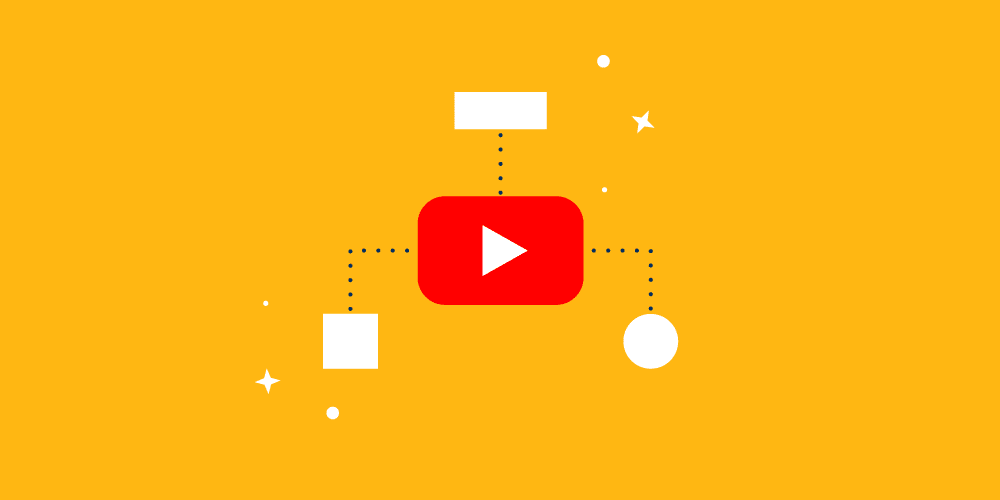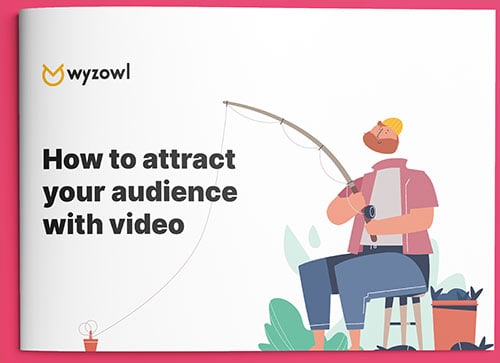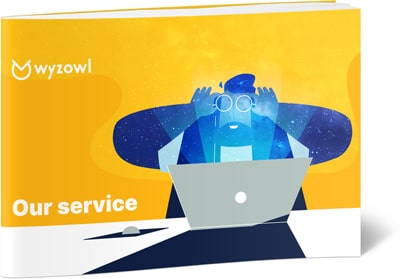Last updated on 10th January 2024
In this article we’re going to take a look at how the YouTube algorithm works in 2024.
If you want to be successful on YouTube, then understanding how the algorithm works is a must.
Why?
Well, YouTube’s algorithm actually drives 70% of what people watch on the platform. So if you want people to find your videos, you need to play by the algorithm’s rules.
And we want to help you! We’re going to take a look at everything you need to know about the YouTube algorithm – from the history to misconceptions to how it works in 2024 – so you can make more informed video marketing decisions.
A brief history of the YouTube algorithm
2005 – 2007 (pre-algorithm)
Like most great inventions, YouTube was created to solve a problem. And the problem was that it was difficult to share videos online.
Enter: YouTube.
Here’s what the platform looked like in 2005:
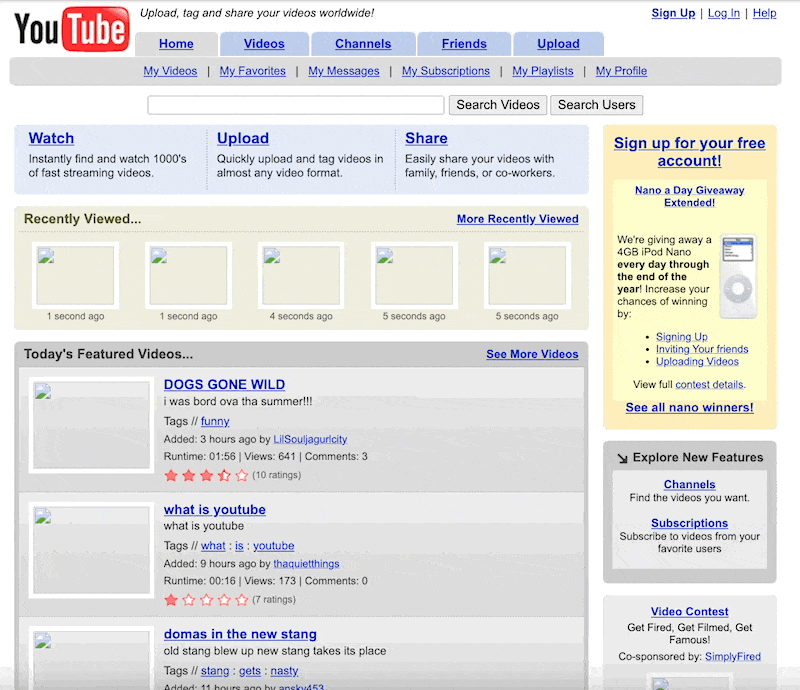
Source: Wayback Machine
This was YouTube, pre-algorithm. Although, there were ways to get your video noticed. As you can see, there are tags on the right-hand side (the bigger the tag, the more popular it was). And we can also see videos featured on the home page.
But, if you look closely, you’ll notice that these aren’t in any particular order that would suggest an algorithm at play. These are the most popular videos on a random day in 2005:
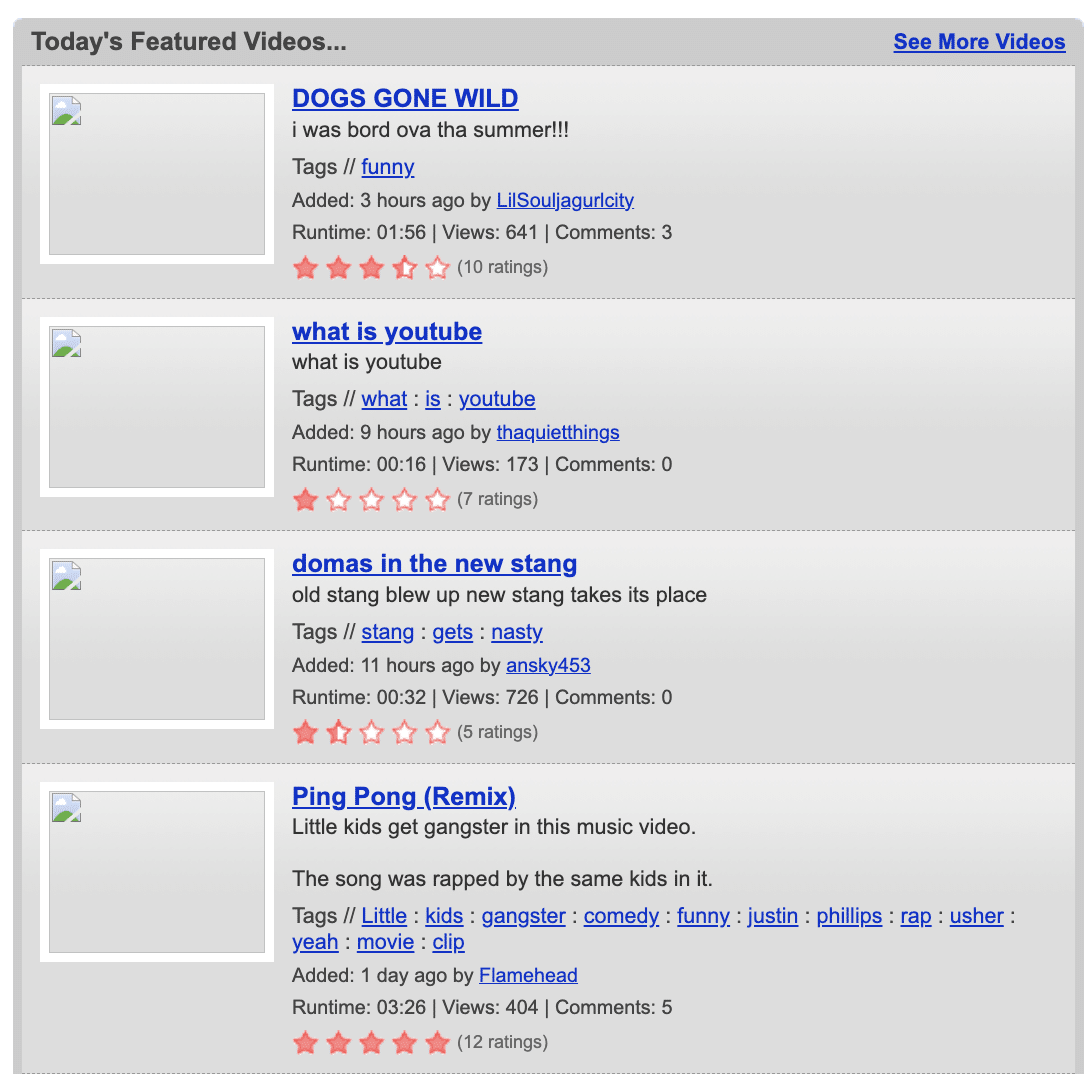
The video with the best ratings is 4th. The video with the most views is 3rd. The video that comes in first place only has one tag. So, it’s really difficult to grasp how these videos were being organised.
And, according to some, it’s because these videos were manually curated in YouTube’s early days. Basically, it was one person’s job to trawl through all of the videos uploaded on YouTube and put their favourites on the homepage. Imagine having that kind of power today!
Of course, as more and more videos were being uploaded, YouTube needed to find a different way to organise their video content. And they decided on views.
Videos with the most views were suggested to all users, regardless of the topic or content of the video. Here’s an example from 2007:
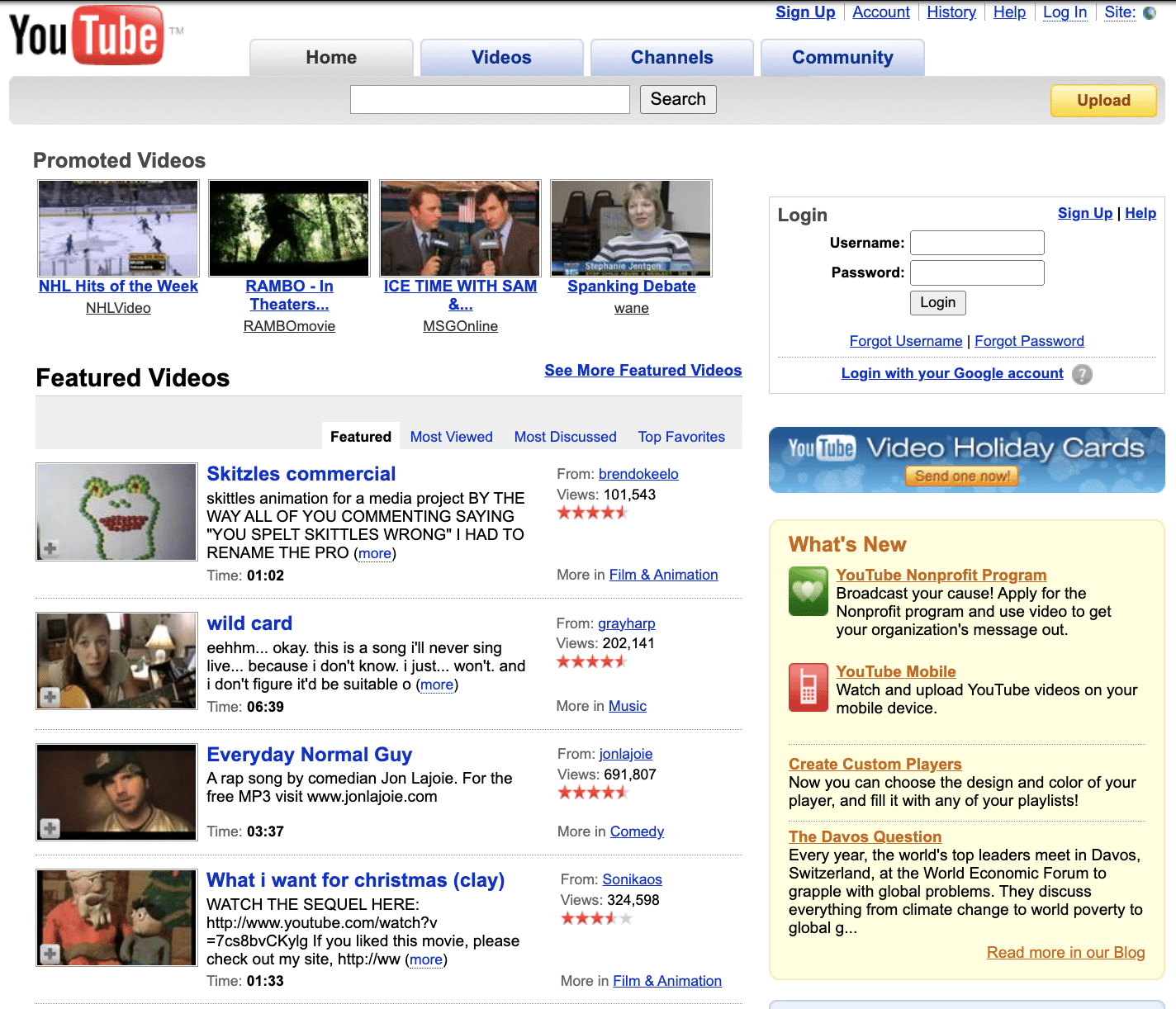
The problem with this, of course, is that you end up catering to only one group of people. This ‘organise by views’ method didn’t (or rather, couldn’t) take into account different cultures, different languages, and basically anyone else who had interests that didn’t match that of the average YouTube user pre-2008.
2008 – 2011 (the recommendation system)
YouTube made a big change in 2008 when they started building their recommendation system.
According to a 2021 article by Cristos Goodrow (VP of Engineering at YouTube at the time), not a lot of people watched the videos in YouTube’s featured section prior to 2008 because (as mentioned) they weren’t relevant enough to individual users. Instead, the majority of YouTube’s viewership came from search results and shared links.
To change this, the team started working on a recommendation system. Goodrow explains:
“We start with the knowledge that everyone has unique viewing habits. Our system then compares your viewing habits with those that are similar to you and uses that information to suggest other content you may want to watch. So if you like tennis videos and our system notices that others who like the same tennis videos as you also enjoy jazz videos, you may be recommended jazz videos, even if you’ve never watched a single one before.”
As such, the home page in 2009 looked more like this:
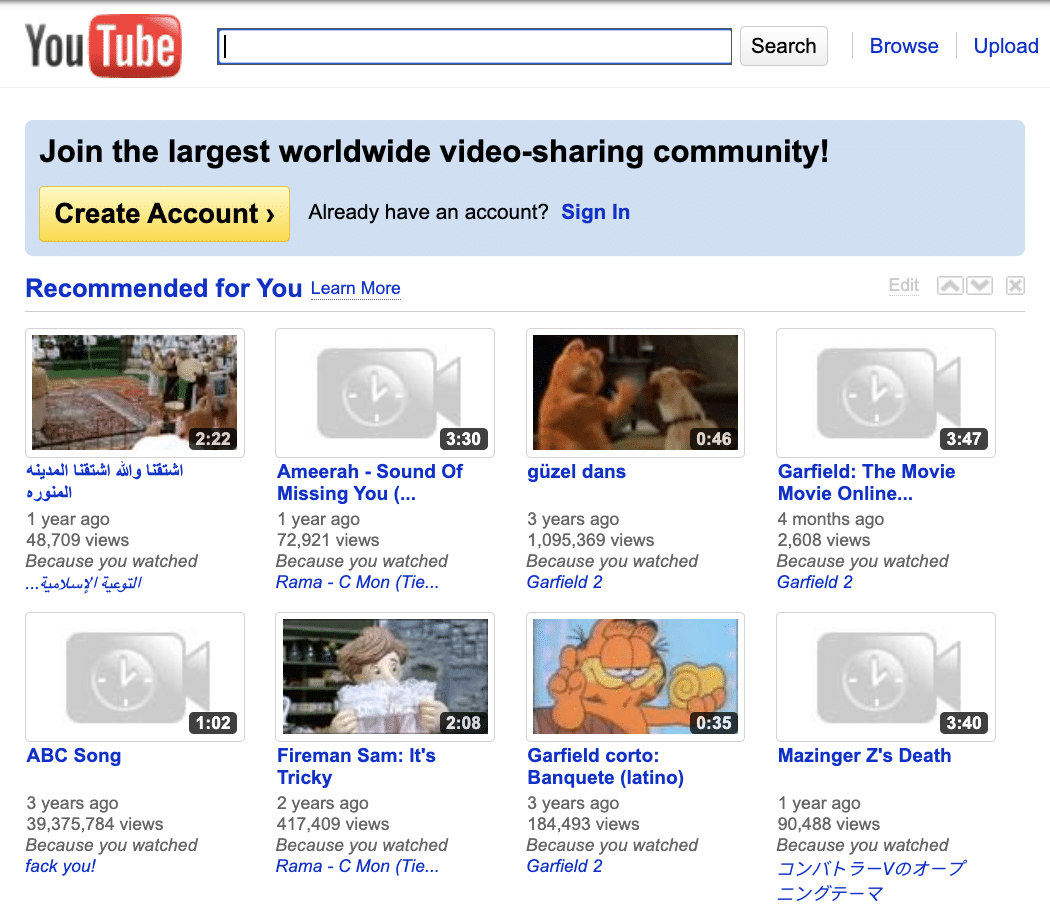
The algorithm was starting to take shape. But there were still some issues. Clicks and views continued to be the primary ways to rank videos in terms of popularity, and this led to an increase of what we now call ‘clickbait’ – the use of a misleading video title and/or video thumbnail to increase YouTube video views.
By 2011, YouTube started tweaking the algorithm to try and figure this out. They learned that just because users clicked on a video didn’t mean they watched it. They also built classifiers at this time to actively prevent certain videos from being recommended, for example, videos that were racy or violent.
2012 – 2015 (introducing watch time)
YouTube wanted to make more personalised recommendations, so they started to pay attention to watch time (which is the amount of time a user spends watching a particular video).
Surprisingly, after implementing this they saw an immediate 20% drop in views. However, they stuck with it, believing it was more important to focus on delivering value to viewers by showing them content that they usually watch (over content that was just clicked on a lot).
With watch time, YouTube was able to start recommending users relevant content that they might like across multiple categories. Here’s a YouTube home page from 2014:
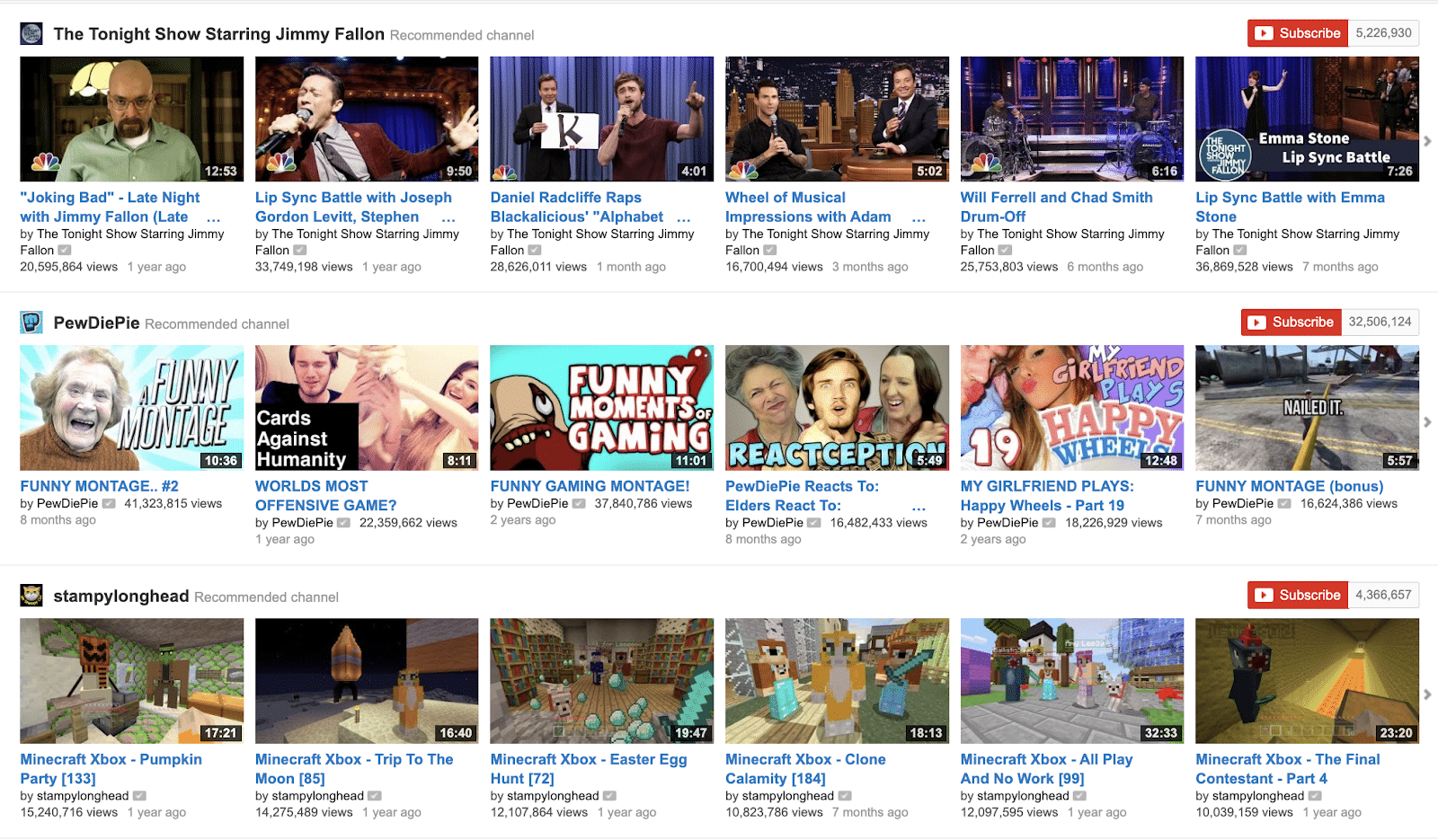
As you can see, most of the content on this user’s home page comes from recommended channels (based on their watch history).
Another thing the YouTube algorithm started taking into account during this time is likes, shares, and dislikes. This information gave YouTube’s algorithm more solid information on what users wanted to see, and what they didn’t.
2015 – 2017 (increasing social responsibility)
By 2015, YouTube’s user base had surpassed the billion mark and the platform started to consider their social responsibility.
There was a shift towards ‘responsible’ recommendations as more people started heading to YouTube for their news content. In 2015, the platform took steps to prevent sensationalistic tabloid content from appearing on homepages.
The idea of what was a responsible recommendation and what was not expanded further during this time, and in 2017 YouTube began evaluating the machine learning that powered fairness across protected groups, such as the LGBTQ+ community.
2017 – present (deep learning)
As you can probably tell, the YouTube algorithm hasn’t necessarily changed over the years – from one thing to another – rather, it’s grown more intelligent and more layers have been added.
These layers continued to build from 2017 to involve more deep learning and tighter control on harmful content and misinformation.
One of the biggest changes during this time was a 2019 update to begin demoting ‘borderline content’, this is content that comes close to violating YouTube’s Community Guidelines without actually doing so.
YouTube uses classifiers to identify whether a video is ‘authoritative’ or ‘borderline’, and they actually went old school with this, bringing in human evaluators to assess the quality of information across different videos and channels.
3 biggest misconceptions about the YouTube algorithm
There’s a lot of information out there about the YouTube algorithm, but not all of it is true. And some of these misconceptions can make it difficult to understand how the YouTube algorithm works.
Here are 3 of the biggest misconceptions:
1. The algorithm is there to find an audience for your videos
While this seems perfectly logical, it’s not true. In fact, the exact opposite is true. The algorithm suggests videos that are a good fit for viewers, based on audience behaviour, rather than finding a YouTube audience that’s a good fit for your videos.
This is an important thing to understand and keep in mind when creating video content for your YouTube channel, because if your videos don’t match what people are looking for then YouTube simply won’t push your videos out to viewers.
2. There’s only one algorithm
This can be confusing because many outlets – including this one – will refer to the YouTube algorithm (singular), but in reality it’s actually a system of algorithms that work in conjunction with one another.
For example, the ‘search’ algorithm is different from the ‘trending’ algorithm, because they’re both looking for different things. There’s also algorithms for video engagement, channel stickiness, and so much more – that we’ll get into in just a second!
So, it’s important to continuously monitor your video performance to see what works best for your YouTube channel. Just because one video performs really well with the ‘trending’ algorithm doesn’t mean it will match up with what’s required to succeed with the ‘search’ algorithm (for example).
3. YouTube prefers longer videos
While it’s true that longer videos tend to perform better on YouTube than on other social media platforms that aren’t video-centric, that doesn’t mean you should create extra-long videos for the sake of it.
YouTube likes engagement, watch time, and channel stickiness, basically anything that keeps viewers watching and keeps people on YouTube!
It can be easy to mistake this as YouTube preferring longer videos, but if you create long videos that aren’t watched in their entirety then this is likely to have a negative impact on your YouTube success.
How does the YouTube algorithm work in 2024?
Today, the YouTube algorithm constantly learns from over 80 billion signals to help connect people to videos they love.
Unfortunately for video marketers and video creators, there is no handbook that YouTube gives out explaining exactly how the algorithm works. But there is content here and there that gives tidbits of useful information, like this video directly from YouTube:
If you want the TL;DR version, in 2024 the YouTube algorithm is focused on matching each viewer with the videos they’re most likely to watch.
If you want to dig in deeper, let’s take a look at how YouTube makes these matches.
The top-ranking factor for YouTube is viewer satisfaction, and this is measured by how users engage. Engagement refers to things like click through rate, watch duration, and channel stickiness (how long a viewer sticks around on a channel and/or how many other videos they consume by the same creator).
There are other historical factors that can be used to measure this satisfaction too, such as their previously watched videos, their likes and dislikes, topics or channels they regularly watch, and instances when they’ve clicked the ‘not interested’ button.
All of this data then feeds into each user’s individual homepage and suggested videos section, which is why everyone’s YouTube account can look so different!
In addition to viewer satisfaction, there are some other things YouTube considers that can impact the performance of your videos:
- Topic interest – how many people are interested in your video topic
- Competition – how well videos from similar creators are performing
- Seasonality – this just refers to fluctuations based on seasonal events, such as major holidays
The bottom line to remember here is that YouTube’s algorithm is trying to please viewers, so you should also try to please viewers – and think less about how to ‘game the system’.
If viewers are positively engaging with your content, that’s the best message you can send to the YouTube algorithm that your videos are worth watching!
Is the YouTube Shorts algorithm different?
YouTube Shorts started in late 2020. It’s basically YouTube’s answer to snappy, vertical, mobile-first videos (like those shared on TikTok). And these short videos are pretty popular, attracting around 6.5 billion views for the platform every day.
You’ve probably noticed that YouTube Shorts now has a space on your homepage.
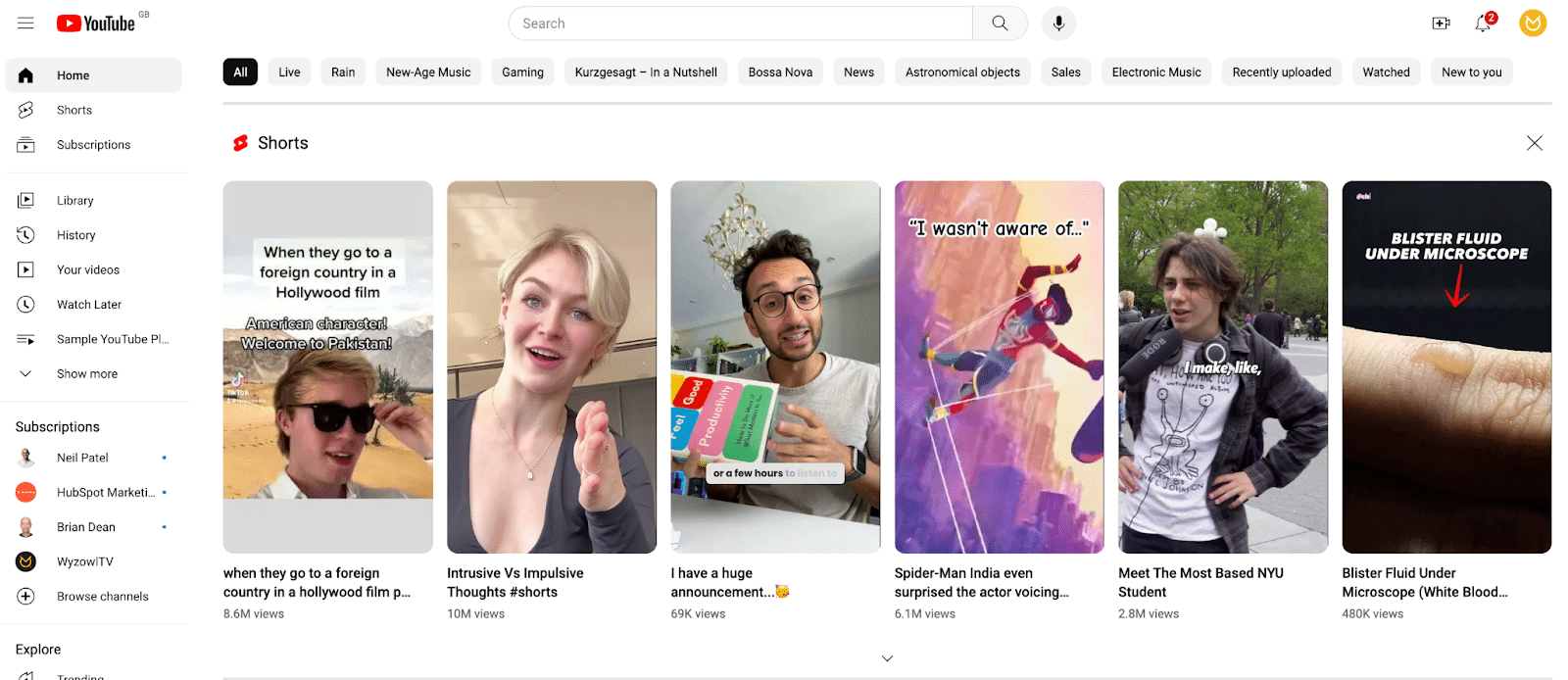
Therefore, the YouTube algorithm must be at play when deciding which Shorts to recommend to you. So, how does it work?
Well, if you’re wondering whether the algorithm for YouTube Shorts is the same as YouTube’s regular algorithm, the answer is: yes and no.
When speaking on the subject, YouTube employees have said that while they recommend long-form and short-form videos to users separately, their reasons for recommending videos are largely the same – relevant content, watch history, engagement, and all that good stuff we’ve already covered.
Essentially, regardless of the type of video, YouTube is always trying to recommend videos that users want to watch. And this can get complicated because, as Todd Sherman (Product Lead for YouTube Shorts) has said, “It’s not like everything that you enjoy in Shorts, you automatically enjoy in long-form. For example, I like to watch people crush some dances in short-form, but I really never seek that out in long-form. Conversely, I enjoy science experiments in both.”
So, just from those two small examples, it’s easy to see how complex the algorithms must be in order to decipher all of this information about a viewer to keep delivering valuable video content to them!
But, the good news is, the bottom line with the YouTube algorithm always seems to be clear and simple: Just make videos that your audience enjoys.
Top 10 tips to improve your video performance on YouTube
1. Conduct robust keyword research
In order for your videos to be suggested by the YouTube algorithm, you need to understand exactly what keywords your target audience are searching for.
By identifying relevant, high-ranking keywords and optimising for those, you can increase the chances of your videos appearing in search results, which will boost the popularity of your videos and hopefully help you reach a wider audience.
Check out this article to find out more: The 11 Best YouTube Keyword Tools in 2024.
2. Optimise your YouTube videos
Speaking of keywords, you need to optimise everything. This includes adding compelling keywords to your video title, video description, and metatags, giving your SEO a boost on the platform.
And it also refers to your video thumbnails. Eye-catching thumbnails can be the difference between someone choosing to click on your video or a competitor’s.
YouTube thumbnails like this work really well:
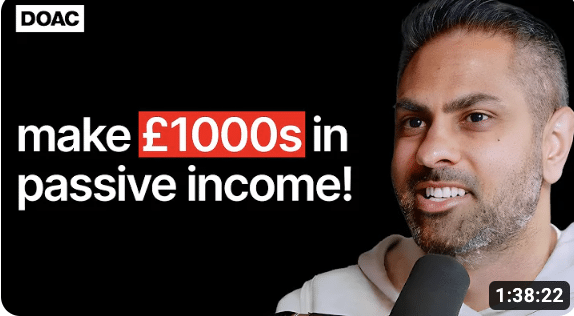
This thumbnail includes an image of the speaker and a surprising statement that will intrigue people scrolling and encourage them to watch the video to find out more.
We can also see the logo in the top-left, which is a nice way to brand the thumbnail. When making thumbnails – just like this one – and working on building your channel, it’s important to keep things consistent.
3. Collaborate with other YouTube users
It should be a no-brainer that collaborating with other YouTubers and content creators can expand your reach and help you attract new subscribers.
But you need to choose wisely! The people you collaborate with should be within your niche and focus on complementary topics, without being direct competitors. Here’s an example from the channel BeardMeatsFood:
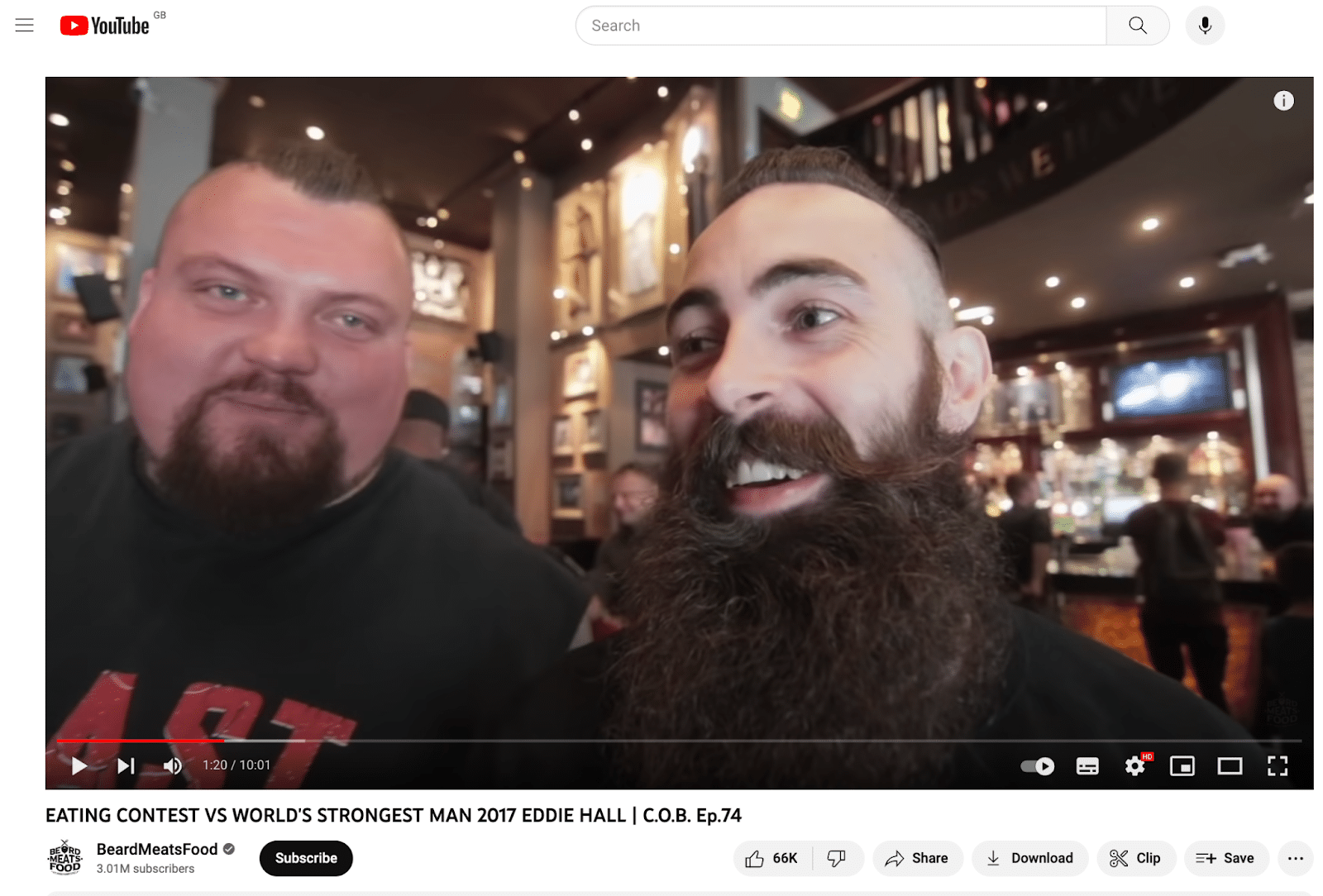
This is a collaboration between a competitive eater and a strongman, so they complement each other as content creators that focus on extreme challenges, without being direct competitors.
4. Use the correct tags
You need to tag your videos correctly in order to help the YouTube algorithm understand the content of your videos so that they can be recommended to the right people.
To find out what the best tags are, do some research in your niche and check out what competitors are doing. You can also conduct A/B testing with your videos to help you further discover what works and what doesn’t when it comes to increasing your video’s discoverability.
5. Build a community around your YouTube channel
Despite its main focus being on video sharing, it’s important to remember that YouTube is a social network. As such, building a loyal community is crucial for long-term success on the platform.
There’s even a Community tab where you can post questions, media, and polls to engage with fans of your YouTube channel and find out more about what they want to see.
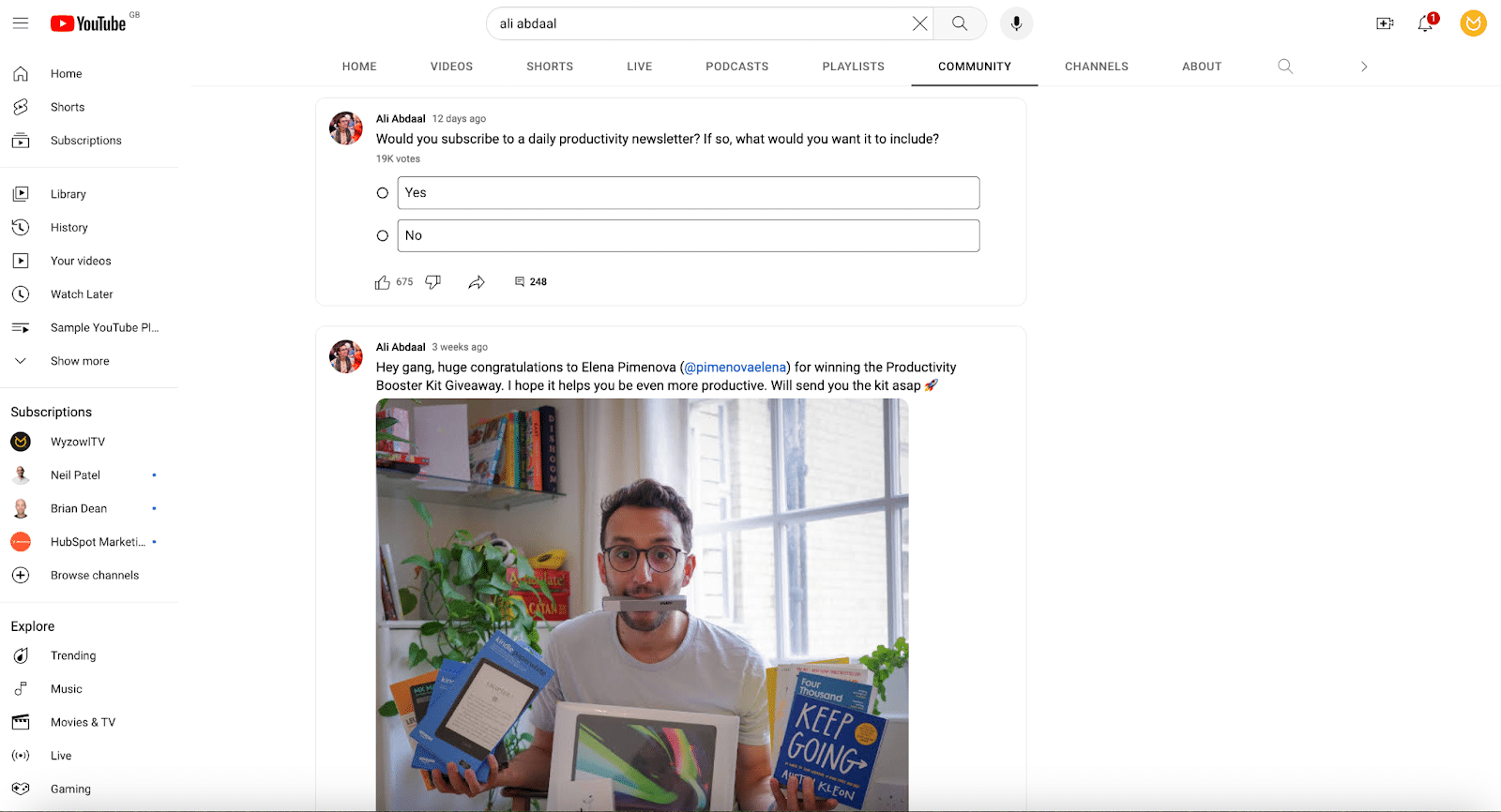
You’ve probably seen at least one YouTube creator start their video with the spiel ‘if you like this video, please give it a thumbs up, leave a comment, and subscribe’ – this is because engagement does drive the algorithm, to an extent.
If you encourage engagement and build a community of loyal viewers who subscribe, watch every video as soon as it’s posted, like and leave a comment, then you send a pretty strong message to YouTube’s algorithm that people want to see your videos.
6. Create playlists
Playlists can increase viewer retention while also enhancing the experience for your audience.
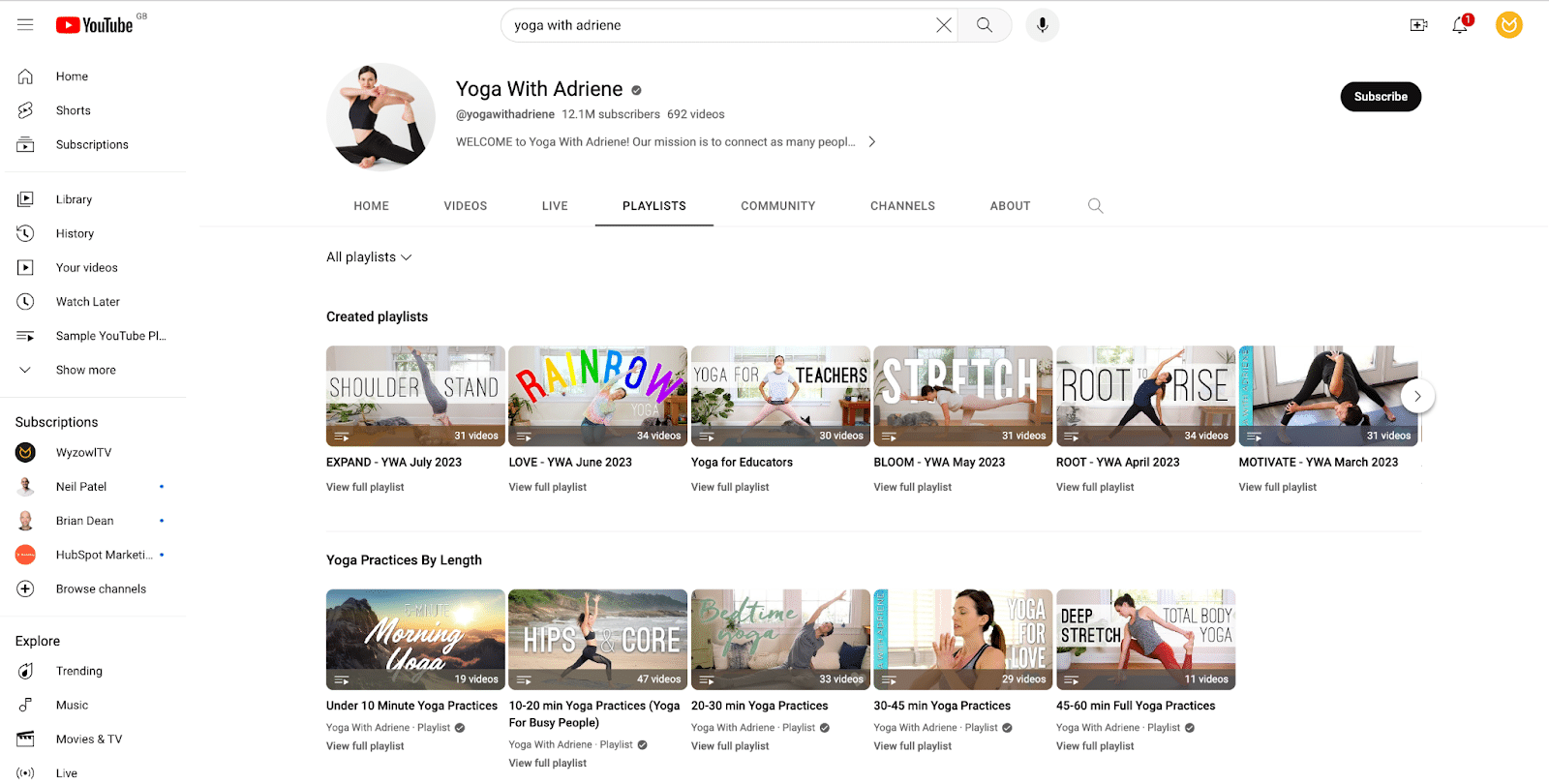
By creating playlists that are grouped into specific or related topics, you can make it easier for viewers to find what they’re looking for and increase the watch time on your YouTube channel.
This increased watch time will send a great message to YouTube that your content is engaging and valuable to users.
7. Make your videos more accessible
It should be obvious, but if you want your videos to have a bigger reach, then you need them to appeal to a bigger audience.
Create videos that are more accessible by utilising closed captions (so that viewers with hearing impairments can enjoy your content). You can also expand your reach by providing subtitles in different languages, increasing viewer engagement internationally.
8. Utilise end screen templates
Another way to keep people watching your videos is to utilise YouTube’s end screen templates to encourage viewers to check out more of your content.
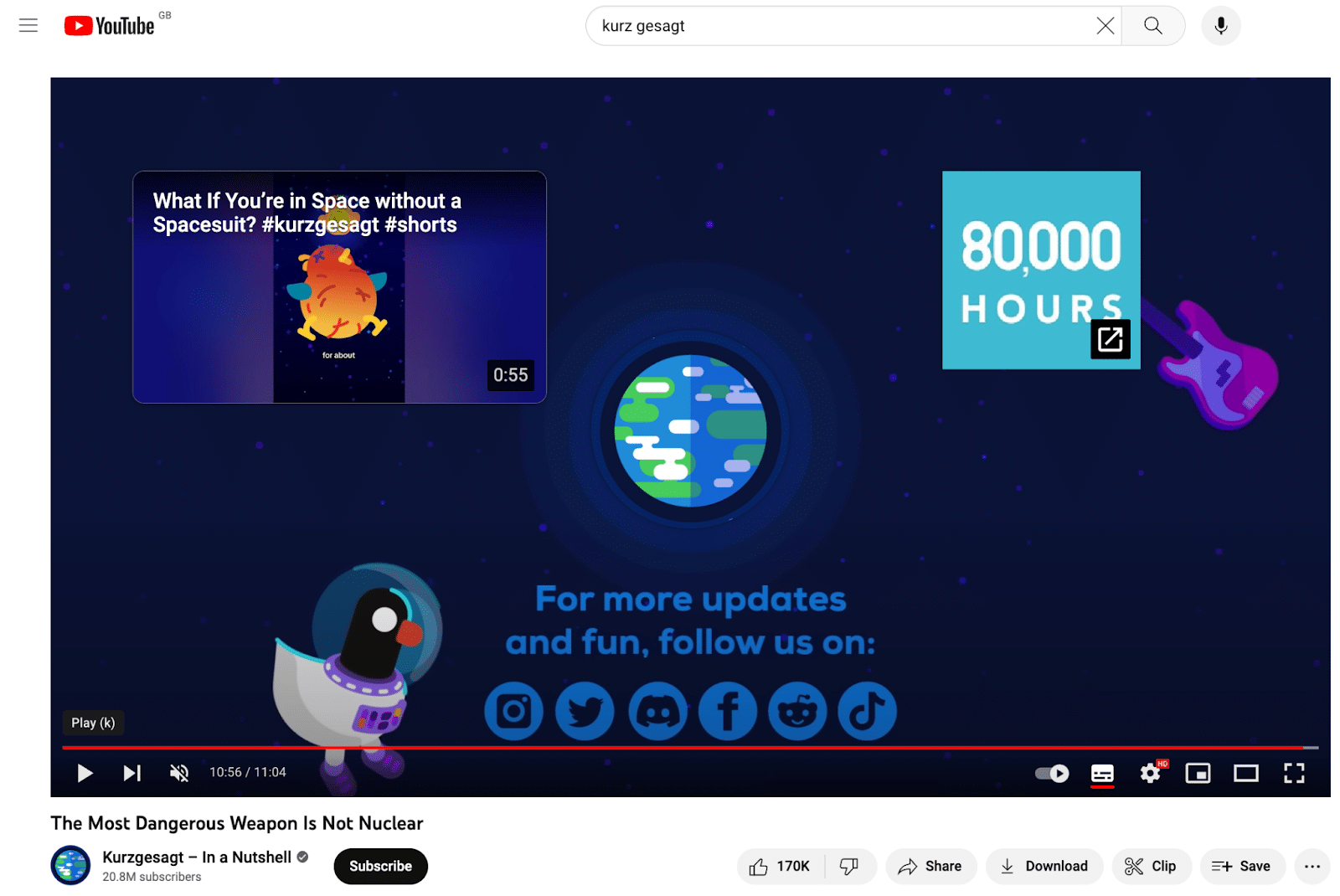
Just like playlists, end screen templates can increase viewer retention and boost the overall watch time of your channel. This will send a clear message to YouTube that people enjoy your content and want to see more.
9. Stick to a consistent posting schedule
Posting new videos regularly sends the signal to YouTube and your audience that your channel is active and committed to regular content.
Maintaining a level of consistency when it comes to the day and times your YouTube videos are posted can also help to build anticipation among viewers and help boost your views immediately after posting.
10. Pay attention to your analytics
YouTube’s free analytics offer video creators a goldmine of valuable information! You can find out your watch time, the demographics of your audience, the number of new viewers you have versus returning people and subscribers, and so much more.
Don’t let these insights go to waste. By studying them you can identify trends that will help you to adjust your content so that you deliver the types of videos your audience want to see.
Final thoughts
If you want your video marketing efforts to be successful then understanding how YouTube works is imperative.
By reading this guide to the YouTube algorithm in 2024, you’ve made great strides towards improving your performance on the platform.
Want to find out more? Look no further. We’ve got everything you need from How to Get More Views on YouTube to How to Create a Successful YouTube Video Ads Campaign and even a YouTube channel banner size guide.

